Commonwealth Bank's Market Entry Strategy: China vs. Belgium Analysis
VerifiedAdded on 2023/06/08
|11
|2950
|277
Report
AI Summary
This report analyzes the macro-environmental and geopolitical factors impacting the markets of China and Belgium to assess their suitability for market entry by the Commonwealth Bank of Australia (CBA). It begins with an introduction to CBA and its operations, followed by an overview of the market entry challenges and opportunities in both China and Belgium. The report then delves into a detailed analysis of the current macro-environmental and geopolitical forces affecting each country, including inflation rates, trade policies, and government regulations. It further examines the development of trade and business policies in both nations and assesses the potential dangers, risks, and opportunities associated with their current and short-term policies. The report concludes by recommending China as the more suitable market for CBA's entry, citing its favorable macro-environment and geopolitical factors, reduced business risk, and high investment opportunities compared to Belgium. Desklib offers a range of similar reports and study tools for students.
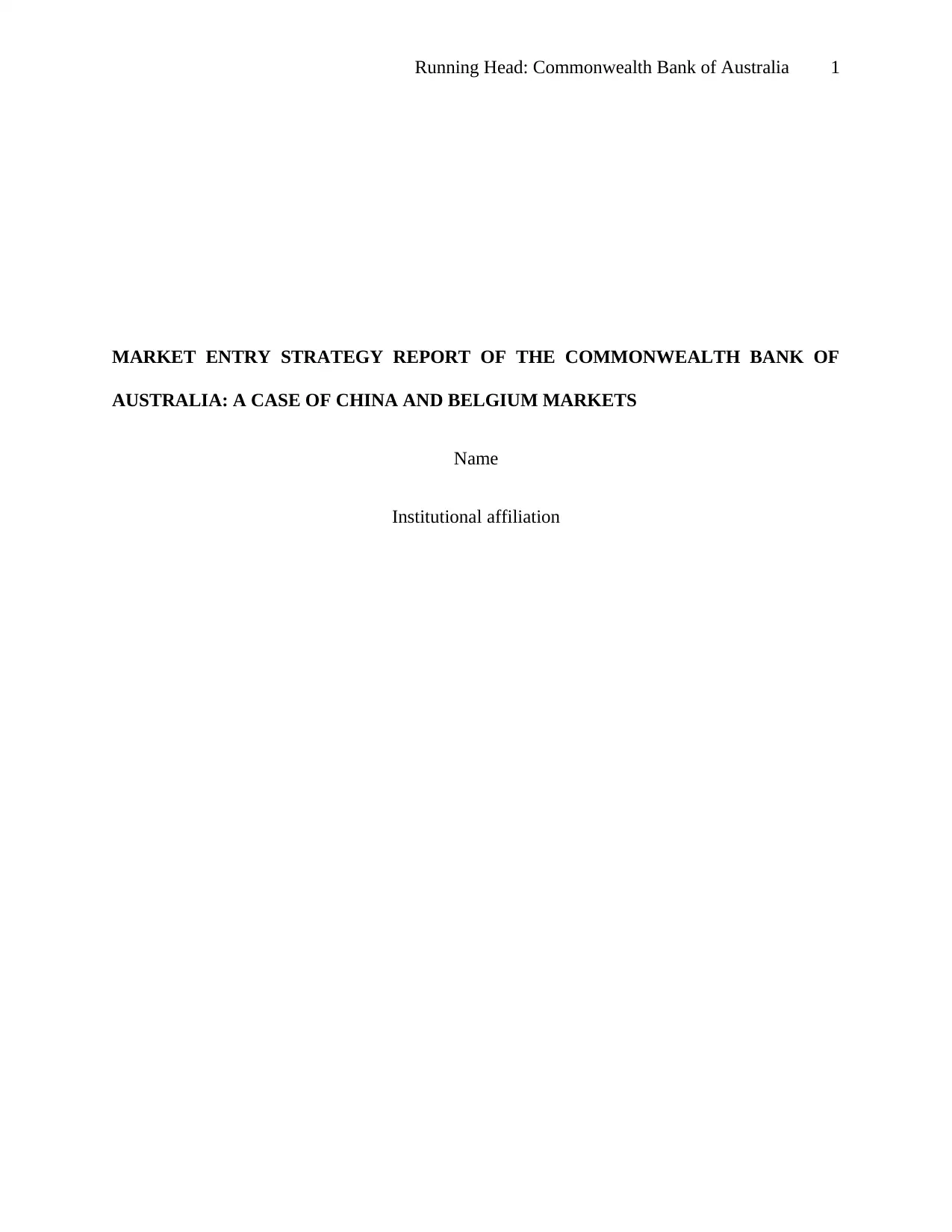
Running Head: Commonwealth Bank of Australia 1
MARKET ENTRY STRATEGY REPORT OF THE COMMONWEALTH BANK OF
AUSTRALIA: A CASE OF CHINA AND BELGIUM MARKETS
Name
Institutional affiliation
MARKET ENTRY STRATEGY REPORT OF THE COMMONWEALTH BANK OF
AUSTRALIA: A CASE OF CHINA AND BELGIUM MARKETS
Name
Institutional affiliation
Paraphrase This Document
Need a fresh take? Get an instant paraphrase of this document with our AI Paraphraser
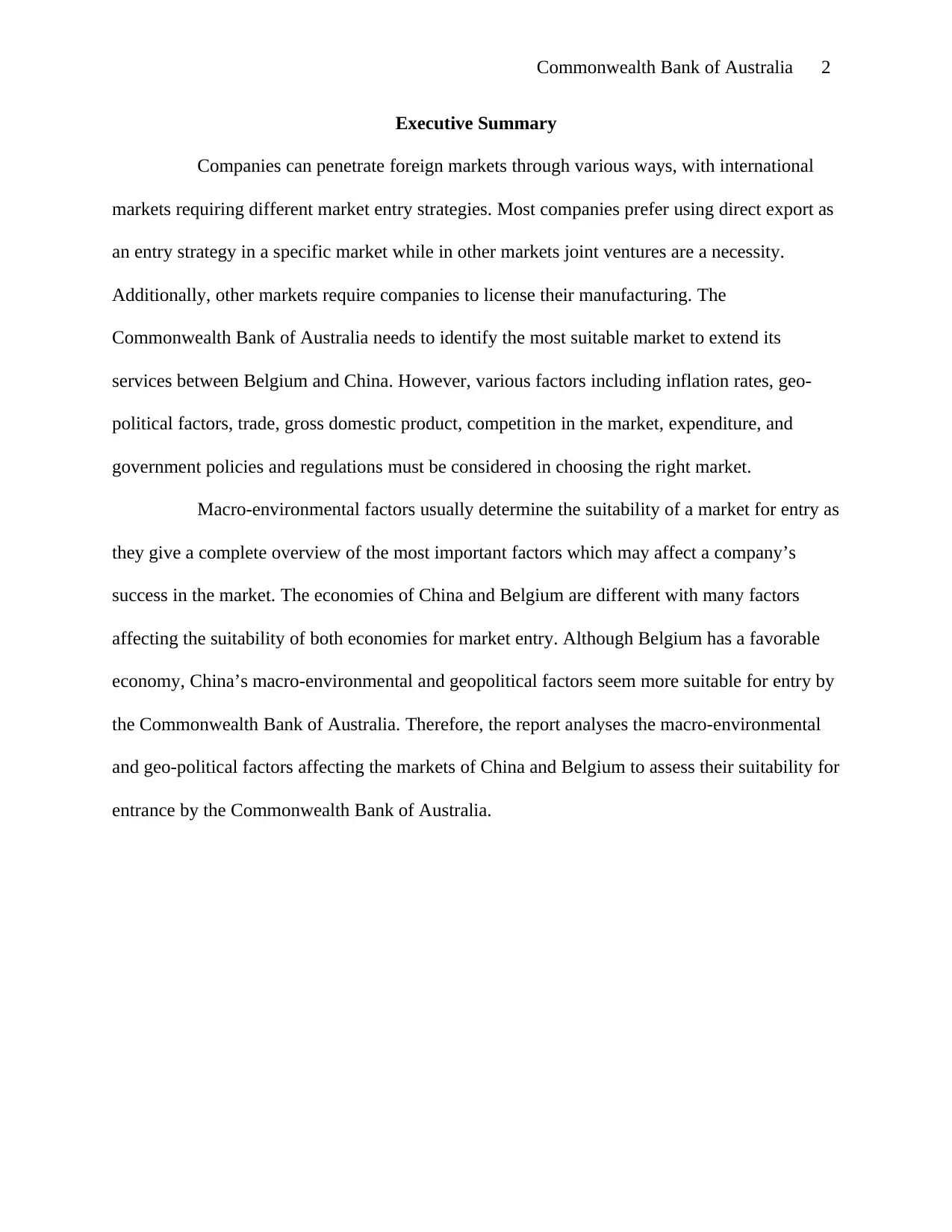
Commonwealth Bank of Australia 2
Executive Summary
Companies can penetrate foreign markets through various ways, with international
markets requiring different market entry strategies. Most companies prefer using direct export as
an entry strategy in a specific market while in other markets joint ventures are a necessity.
Additionally, other markets require companies to license their manufacturing. The
Commonwealth Bank of Australia needs to identify the most suitable market to extend its
services between Belgium and China. However, various factors including inflation rates, geo-
political factors, trade, gross domestic product, competition in the market, expenditure, and
government policies and regulations must be considered in choosing the right market.
Macro-environmental factors usually determine the suitability of a market for entry as
they give a complete overview of the most important factors which may affect a company’s
success in the market. The economies of China and Belgium are different with many factors
affecting the suitability of both economies for market entry. Although Belgium has a favorable
economy, China’s macro-environmental and geopolitical factors seem more suitable for entry by
the Commonwealth Bank of Australia. Therefore, the report analyses the macro-environmental
and geo-political factors affecting the markets of China and Belgium to assess their suitability for
entrance by the Commonwealth Bank of Australia.
Executive Summary
Companies can penetrate foreign markets through various ways, with international
markets requiring different market entry strategies. Most companies prefer using direct export as
an entry strategy in a specific market while in other markets joint ventures are a necessity.
Additionally, other markets require companies to license their manufacturing. The
Commonwealth Bank of Australia needs to identify the most suitable market to extend its
services between Belgium and China. However, various factors including inflation rates, geo-
political factors, trade, gross domestic product, competition in the market, expenditure, and
government policies and regulations must be considered in choosing the right market.
Macro-environmental factors usually determine the suitability of a market for entry as
they give a complete overview of the most important factors which may affect a company’s
success in the market. The economies of China and Belgium are different with many factors
affecting the suitability of both economies for market entry. Although Belgium has a favorable
economy, China’s macro-environmental and geopolitical factors seem more suitable for entry by
the Commonwealth Bank of Australia. Therefore, the report analyses the macro-environmental
and geo-political factors affecting the markets of China and Belgium to assess their suitability for
entrance by the Commonwealth Bank of Australia.
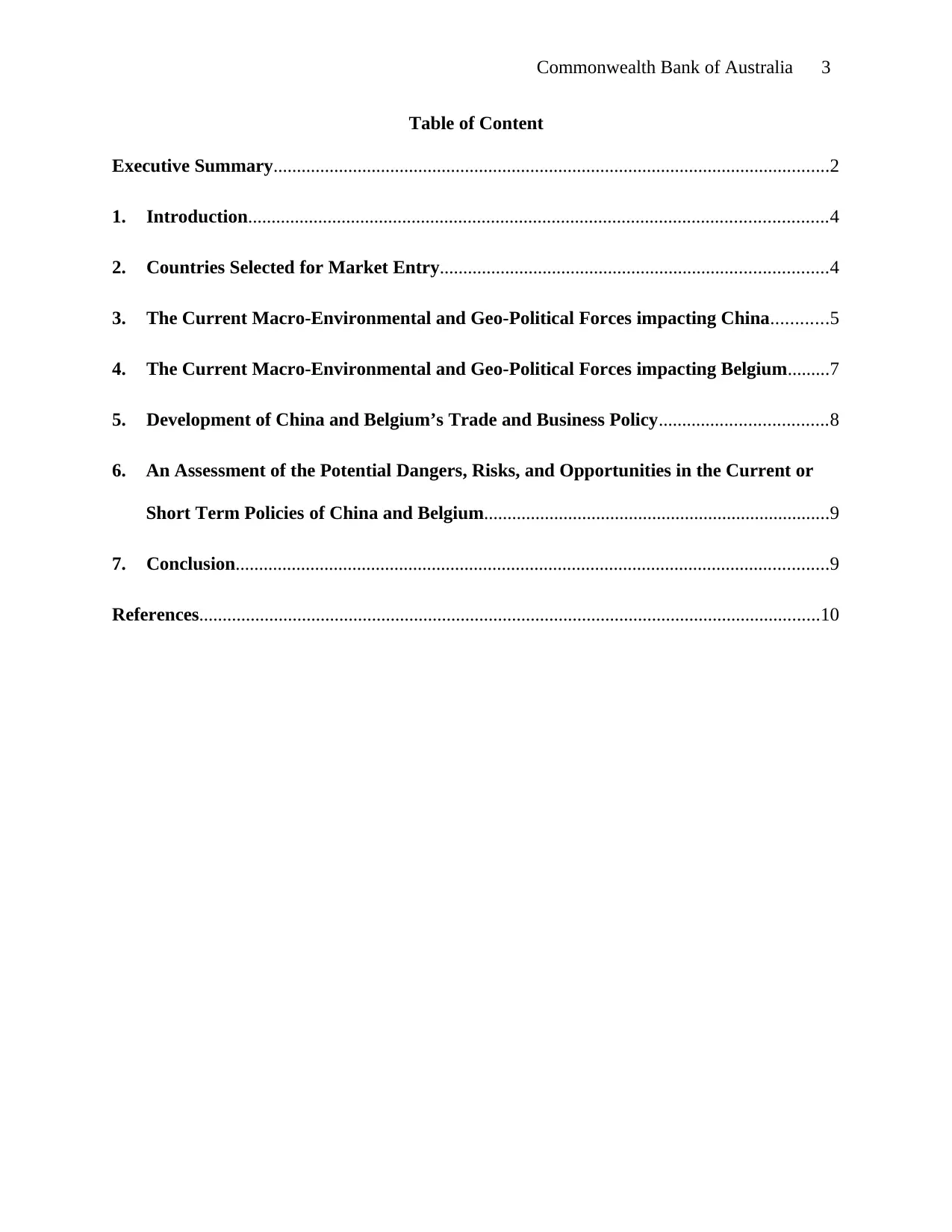
Commonwealth Bank of Australia 3
Table of Content
Executive Summary.......................................................................................................................2
1. Introduction............................................................................................................................4
2. Countries Selected for Market Entry...................................................................................4
3. The Current Macro-Environmental and Geo-Political Forces impacting China............5
4. The Current Macro-Environmental and Geo-Political Forces impacting Belgium.........7
5. Development of China and Belgium’s Trade and Business Policy....................................8
6. An Assessment of the Potential Dangers, Risks, and Opportunities in the Current or
Short Term Policies of China and Belgium..........................................................................9
7. Conclusion...............................................................................................................................9
References.....................................................................................................................................10
Table of Content
Executive Summary.......................................................................................................................2
1. Introduction............................................................................................................................4
2. Countries Selected for Market Entry...................................................................................4
3. The Current Macro-Environmental and Geo-Political Forces impacting China............5
4. The Current Macro-Environmental and Geo-Political Forces impacting Belgium.........7
5. Development of China and Belgium’s Trade and Business Policy....................................8
6. An Assessment of the Potential Dangers, Risks, and Opportunities in the Current or
Short Term Policies of China and Belgium..........................................................................9
7. Conclusion...............................................................................................................................9
References.....................................................................................................................................10
⊘ This is a preview!⊘
Do you want full access?
Subscribe today to unlock all pages.

Trusted by 1+ million students worldwide
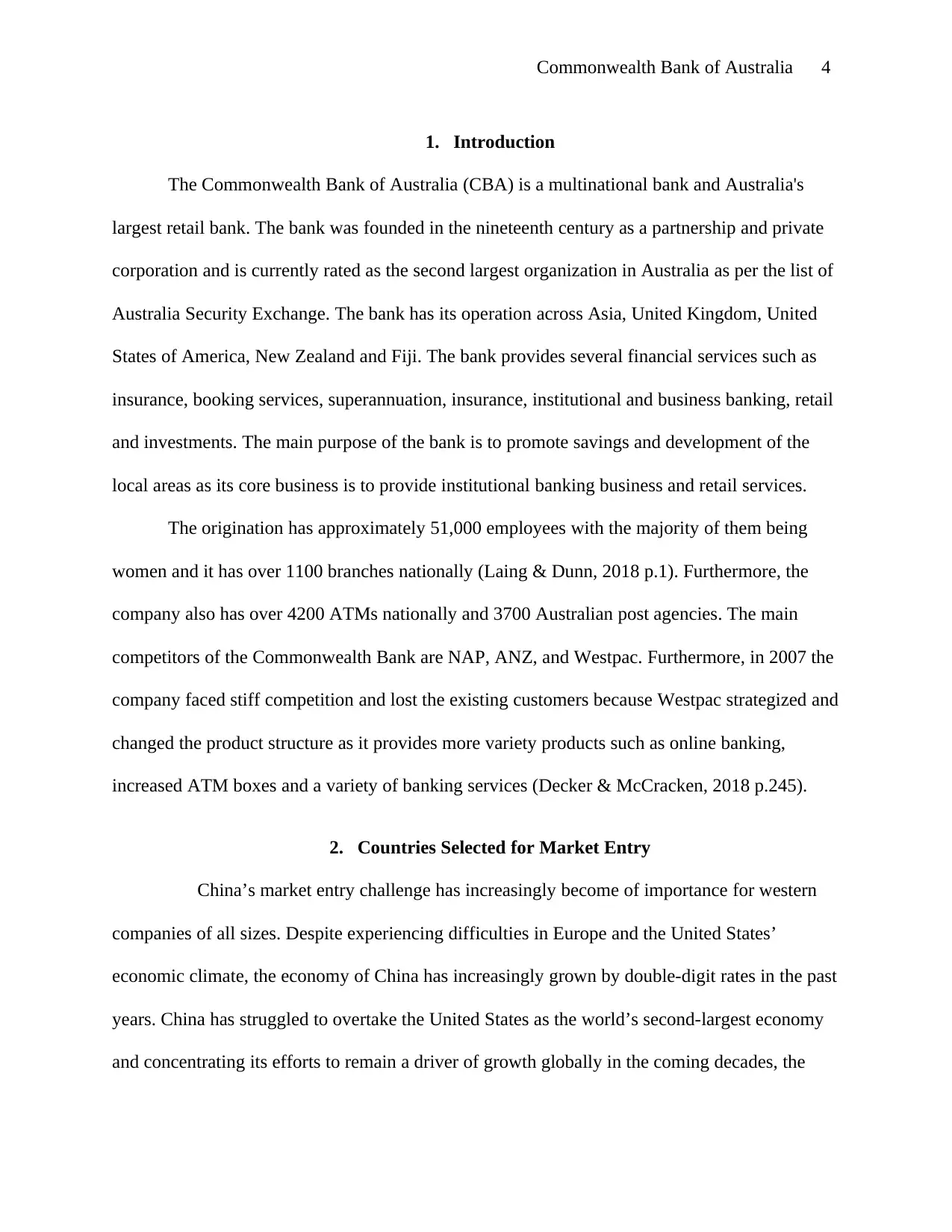
Commonwealth Bank of Australia 4
1. Introduction
The Commonwealth Bank of Australia (CBA) is a multinational bank and Australia's
largest retail bank. The bank was founded in the nineteenth century as a partnership and private
corporation and is currently rated as the second largest organization in Australia as per the list of
Australia Security Exchange. The bank has its operation across Asia, United Kingdom, United
States of America, New Zealand and Fiji. The bank provides several financial services such as
insurance, booking services, superannuation, insurance, institutional and business banking, retail
and investments. The main purpose of the bank is to promote savings and development of the
local areas as its core business is to provide institutional banking business and retail services.
The origination has approximately 51,000 employees with the majority of them being
women and it has over 1100 branches nationally (Laing & Dunn, 2018 p.1). Furthermore, the
company also has over 4200 ATMs nationally and 3700 Australian post agencies. The main
competitors of the Commonwealth Bank are NAP, ANZ, and Westpac. Furthermore, in 2007 the
company faced stiff competition and lost the existing customers because Westpac strategized and
changed the product structure as it provides more variety products such as online banking,
increased ATM boxes and a variety of banking services (Decker & McCracken, 2018 p.245).
2. Countries Selected for Market Entry
China’s market entry challenge has increasingly become of importance for western
companies of all sizes. Despite experiencing difficulties in Europe and the United States’
economic climate, the economy of China has increasingly grown by double-digit rates in the past
years. China has struggled to overtake the United States as the world’s second-largest economy
and concentrating its efforts to remain a driver of growth globally in the coming decades, the
1. Introduction
The Commonwealth Bank of Australia (CBA) is a multinational bank and Australia's
largest retail bank. The bank was founded in the nineteenth century as a partnership and private
corporation and is currently rated as the second largest organization in Australia as per the list of
Australia Security Exchange. The bank has its operation across Asia, United Kingdom, United
States of America, New Zealand and Fiji. The bank provides several financial services such as
insurance, booking services, superannuation, insurance, institutional and business banking, retail
and investments. The main purpose of the bank is to promote savings and development of the
local areas as its core business is to provide institutional banking business and retail services.
The origination has approximately 51,000 employees with the majority of them being
women and it has over 1100 branches nationally (Laing & Dunn, 2018 p.1). Furthermore, the
company also has over 4200 ATMs nationally and 3700 Australian post agencies. The main
competitors of the Commonwealth Bank are NAP, ANZ, and Westpac. Furthermore, in 2007 the
company faced stiff competition and lost the existing customers because Westpac strategized and
changed the product structure as it provides more variety products such as online banking,
increased ATM boxes and a variety of banking services (Decker & McCracken, 2018 p.245).
2. Countries Selected for Market Entry
China’s market entry challenge has increasingly become of importance for western
companies of all sizes. Despite experiencing difficulties in Europe and the United States’
economic climate, the economy of China has increasingly grown by double-digit rates in the past
years. China has struggled to overtake the United States as the world’s second-largest economy
and concentrating its efforts to remain a driver of growth globally in the coming decades, the
Paraphrase This Document
Need a fresh take? Get an instant paraphrase of this document with our AI Paraphraser
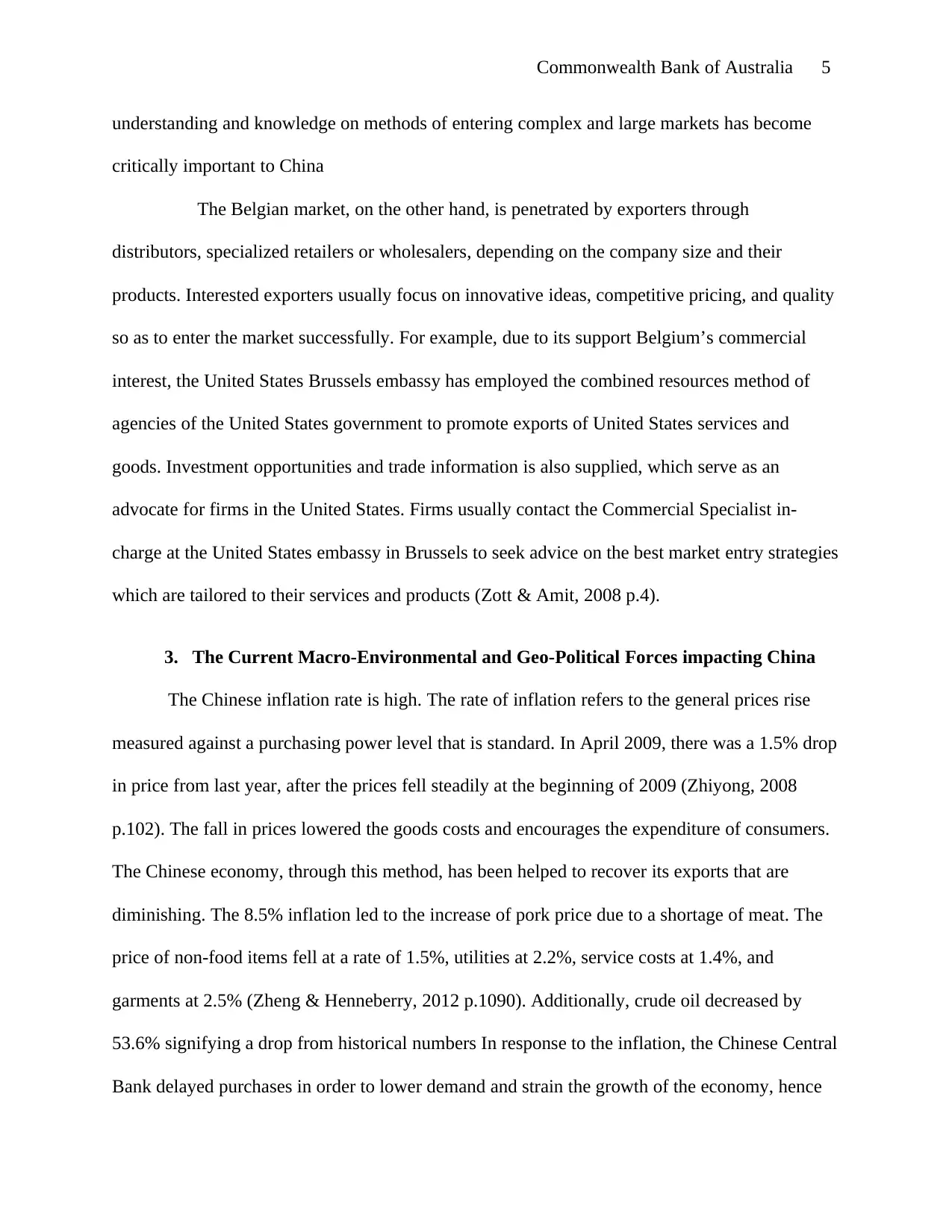
Commonwealth Bank of Australia 5
understanding and knowledge on methods of entering complex and large markets has become
critically important to China
The Belgian market, on the other hand, is penetrated by exporters through
distributors, specialized retailers or wholesalers, depending on the company size and their
products. Interested exporters usually focus on innovative ideas, competitive pricing, and quality
so as to enter the market successfully. For example, due to its support Belgium’s commercial
interest, the United States Brussels embassy has employed the combined resources method of
agencies of the United States government to promote exports of United States services and
goods. Investment opportunities and trade information is also supplied, which serve as an
advocate for firms in the United States. Firms usually contact the Commercial Specialist in-
charge at the United States embassy in Brussels to seek advice on the best market entry strategies
which are tailored to their services and products (Zott & Amit, 2008 p.4).
3. The Current Macro-Environmental and Geo-Political Forces impacting China
The Chinese inflation rate is high. The rate of inflation refers to the general prices rise
measured against a purchasing power level that is standard. In April 2009, there was a 1.5% drop
in price from last year, after the prices fell steadily at the beginning of 2009 (Zhiyong, 2008
p.102). The fall in prices lowered the goods costs and encourages the expenditure of consumers.
The Chinese economy, through this method, has been helped to recover its exports that are
diminishing. The 8.5% inflation led to the increase of pork price due to a shortage of meat. The
price of non-food items fell at a rate of 1.5%, utilities at 2.2%, service costs at 1.4%, and
garments at 2.5% (Zheng & Henneberry, 2012 p.1090). Additionally, crude oil decreased by
53.6% signifying a drop from historical numbers In response to the inflation, the Chinese Central
Bank delayed purchases in order to lower demand and strain the growth of the economy, hence
understanding and knowledge on methods of entering complex and large markets has become
critically important to China
The Belgian market, on the other hand, is penetrated by exporters through
distributors, specialized retailers or wholesalers, depending on the company size and their
products. Interested exporters usually focus on innovative ideas, competitive pricing, and quality
so as to enter the market successfully. For example, due to its support Belgium’s commercial
interest, the United States Brussels embassy has employed the combined resources method of
agencies of the United States government to promote exports of United States services and
goods. Investment opportunities and trade information is also supplied, which serve as an
advocate for firms in the United States. Firms usually contact the Commercial Specialist in-
charge at the United States embassy in Brussels to seek advice on the best market entry strategies
which are tailored to their services and products (Zott & Amit, 2008 p.4).
3. The Current Macro-Environmental and Geo-Political Forces impacting China
The Chinese inflation rate is high. The rate of inflation refers to the general prices rise
measured against a purchasing power level that is standard. In April 2009, there was a 1.5% drop
in price from last year, after the prices fell steadily at the beginning of 2009 (Zhiyong, 2008
p.102). The fall in prices lowered the goods costs and encourages the expenditure of consumers.
The Chinese economy, through this method, has been helped to recover its exports that are
diminishing. The 8.5% inflation led to the increase of pork price due to a shortage of meat. The
price of non-food items fell at a rate of 1.5%, utilities at 2.2%, service costs at 1.4%, and
garments at 2.5% (Zheng & Henneberry, 2012 p.1090). Additionally, crude oil decreased by
53.6% signifying a drop from historical numbers In response to the inflation, the Chinese Central
Bank delayed purchases in order to lower demand and strain the growth of the economy, hence
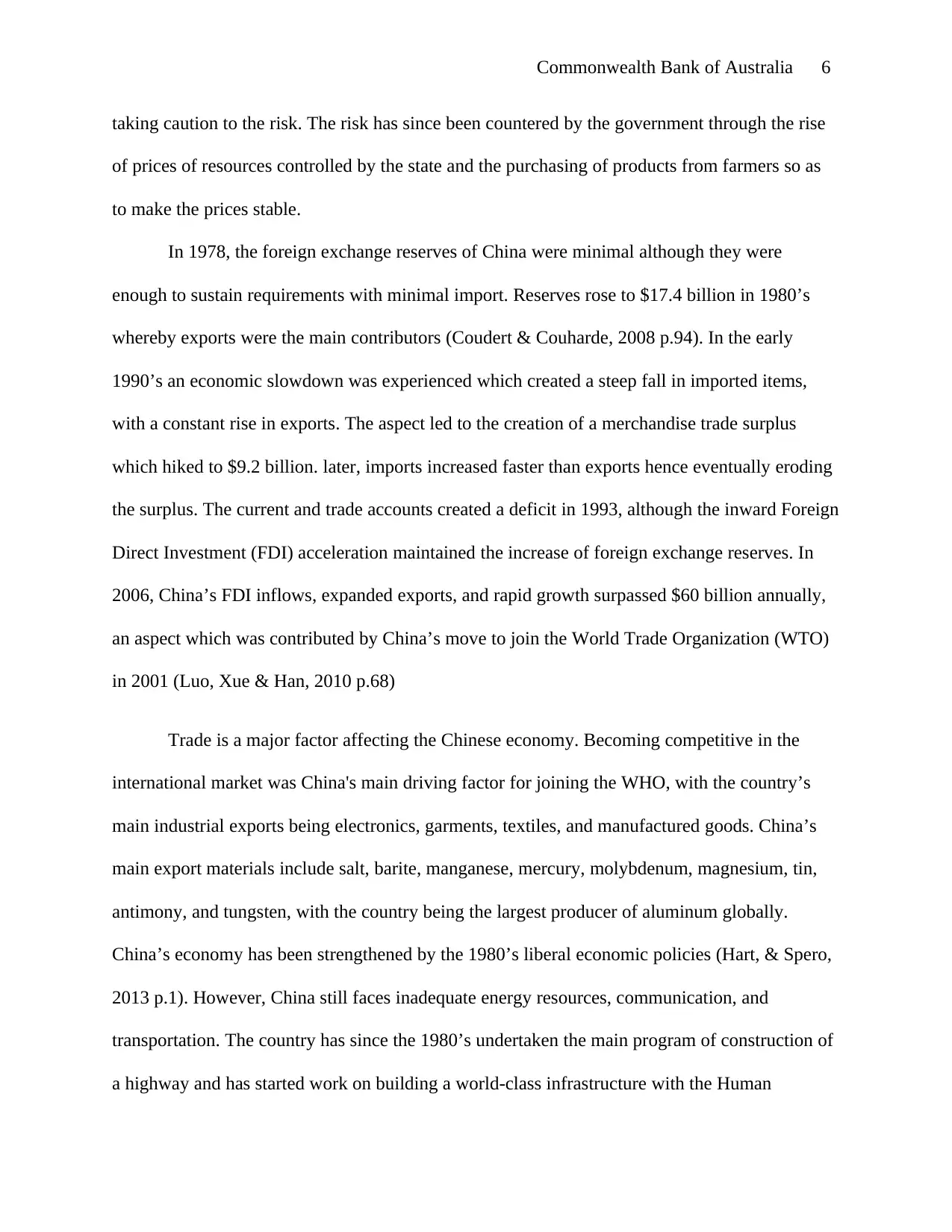
Commonwealth Bank of Australia 6
taking caution to the risk. The risk has since been countered by the government through the rise
of prices of resources controlled by the state and the purchasing of products from farmers so as
to make the prices stable.
In 1978, the foreign exchange reserves of China were minimal although they were
enough to sustain requirements with minimal import. Reserves rose to $17.4 billion in 1980’s
whereby exports were the main contributors (Coudert & Couharde, 2008 p.94). In the early
1990’s an economic slowdown was experienced which created a steep fall in imported items,
with a constant rise in exports. The aspect led to the creation of a merchandise trade surplus
which hiked to $9.2 billion. later, imports increased faster than exports hence eventually eroding
the surplus. The current and trade accounts created a deficit in 1993, although the inward Foreign
Direct Investment (FDI) acceleration maintained the increase of foreign exchange reserves. In
2006, China’s FDI inflows, expanded exports, and rapid growth surpassed $60 billion annually,
an aspect which was contributed by China’s move to join the World Trade Organization (WTO)
in 2001 (Luo, Xue & Han, 2010 p.68)
Trade is a major factor affecting the Chinese economy. Becoming competitive in the
international market was China's main driving factor for joining the WHO, with the country’s
main industrial exports being electronics, garments, textiles, and manufactured goods. China’s
main export materials include salt, barite, manganese, mercury, molybdenum, magnesium, tin,
antimony, and tungsten, with the country being the largest producer of aluminum globally.
China’s economy has been strengthened by the 1980’s liberal economic policies (Hart, & Spero,
2013 p.1). However, China still faces inadequate energy resources, communication, and
transportation. The country has since the 1980’s undertaken the main program of construction of
a highway and has started work on building a world-class infrastructure with the Human
taking caution to the risk. The risk has since been countered by the government through the rise
of prices of resources controlled by the state and the purchasing of products from farmers so as
to make the prices stable.
In 1978, the foreign exchange reserves of China were minimal although they were
enough to sustain requirements with minimal import. Reserves rose to $17.4 billion in 1980’s
whereby exports were the main contributors (Coudert & Couharde, 2008 p.94). In the early
1990’s an economic slowdown was experienced which created a steep fall in imported items,
with a constant rise in exports. The aspect led to the creation of a merchandise trade surplus
which hiked to $9.2 billion. later, imports increased faster than exports hence eventually eroding
the surplus. The current and trade accounts created a deficit in 1993, although the inward Foreign
Direct Investment (FDI) acceleration maintained the increase of foreign exchange reserves. In
2006, China’s FDI inflows, expanded exports, and rapid growth surpassed $60 billion annually,
an aspect which was contributed by China’s move to join the World Trade Organization (WTO)
in 2001 (Luo, Xue & Han, 2010 p.68)
Trade is a major factor affecting the Chinese economy. Becoming competitive in the
international market was China's main driving factor for joining the WHO, with the country’s
main industrial exports being electronics, garments, textiles, and manufactured goods. China’s
main export materials include salt, barite, manganese, mercury, molybdenum, magnesium, tin,
antimony, and tungsten, with the country being the largest producer of aluminum globally.
China’s economy has been strengthened by the 1980’s liberal economic policies (Hart, & Spero,
2013 p.1). However, China still faces inadequate energy resources, communication, and
transportation. The country has since the 1980’s undertaken the main program of construction of
a highway and has started work on building a world-class infrastructure with the Human
⊘ This is a preview!⊘
Do you want full access?
Subscribe today to unlock all pages.

Trusted by 1+ million students worldwide
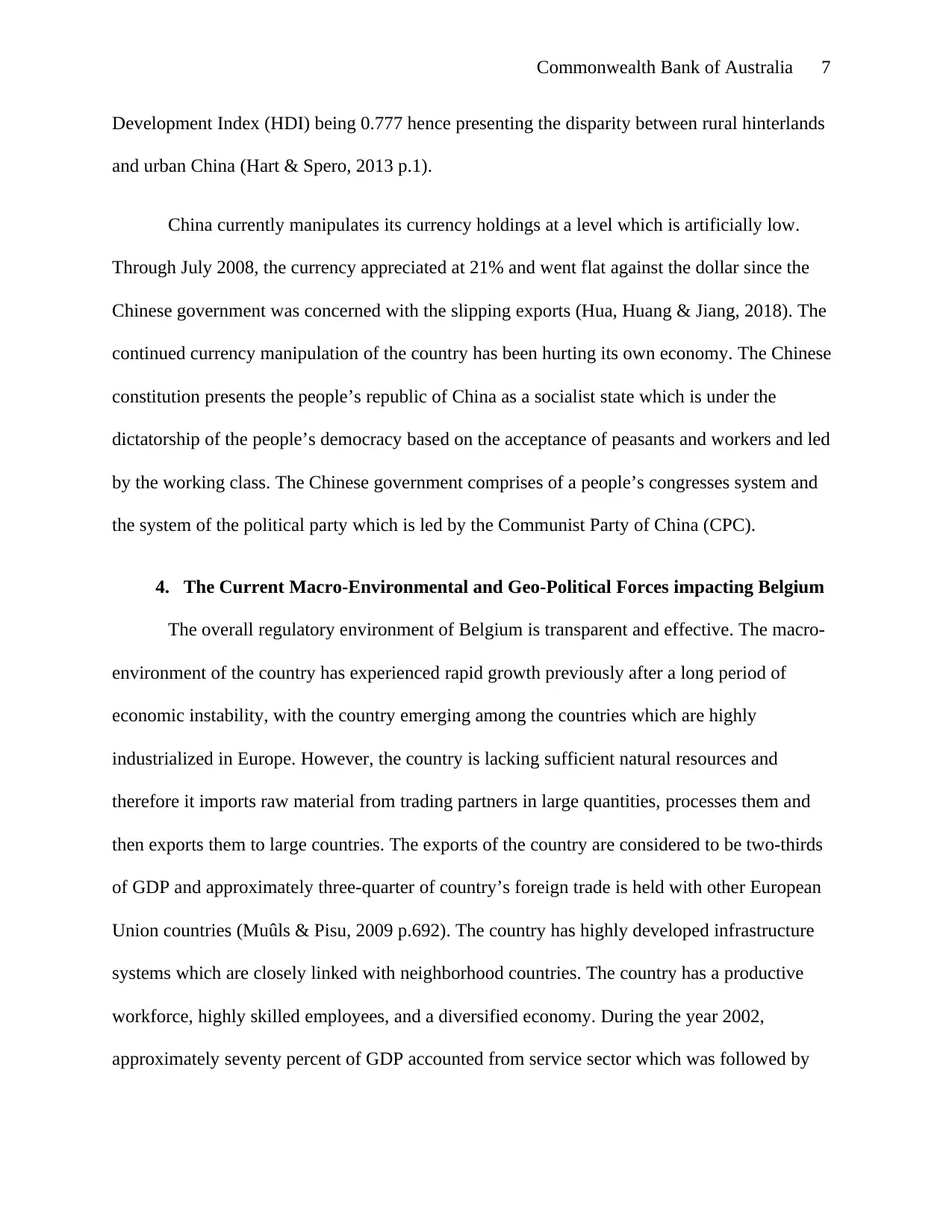
Commonwealth Bank of Australia 7
Development Index (HDI) being 0.777 hence presenting the disparity between rural hinterlands
and urban China (Hart & Spero, 2013 p.1).
China currently manipulates its currency holdings at a level which is artificially low.
Through July 2008, the currency appreciated at 21% and went flat against the dollar since the
Chinese government was concerned with the slipping exports (Hua, Huang & Jiang, 2018). The
continued currency manipulation of the country has been hurting its own economy. The Chinese
constitution presents the people’s republic of China as a socialist state which is under the
dictatorship of the people’s democracy based on the acceptance of peasants and workers and led
by the working class. The Chinese government comprises of a people’s congresses system and
the system of the political party which is led by the Communist Party of China (CPC).
4. The Current Macro-Environmental and Geo-Political Forces impacting Belgium
The overall regulatory environment of Belgium is transparent and effective. The macro-
environment of the country has experienced rapid growth previously after a long period of
economic instability, with the country emerging among the countries which are highly
industrialized in Europe. However, the country is lacking sufficient natural resources and
therefore it imports raw material from trading partners in large quantities, processes them and
then exports them to large countries. The exports of the country are considered to be two-thirds
of GDP and approximately three-quarter of country’s foreign trade is held with other European
Union countries (Muûls & Pisu, 2009 p.692). The country has highly developed infrastructure
systems which are closely linked with neighborhood countries. The country has a productive
workforce, highly skilled employees, and a diversified economy. During the year 2002,
approximately seventy percent of GDP accounted from service sector which was followed by
Development Index (HDI) being 0.777 hence presenting the disparity between rural hinterlands
and urban China (Hart & Spero, 2013 p.1).
China currently manipulates its currency holdings at a level which is artificially low.
Through July 2008, the currency appreciated at 21% and went flat against the dollar since the
Chinese government was concerned with the slipping exports (Hua, Huang & Jiang, 2018). The
continued currency manipulation of the country has been hurting its own economy. The Chinese
constitution presents the people’s republic of China as a socialist state which is under the
dictatorship of the people’s democracy based on the acceptance of peasants and workers and led
by the working class. The Chinese government comprises of a people’s congresses system and
the system of the political party which is led by the Communist Party of China (CPC).
4. The Current Macro-Environmental and Geo-Political Forces impacting Belgium
The overall regulatory environment of Belgium is transparent and effective. The macro-
environment of the country has experienced rapid growth previously after a long period of
economic instability, with the country emerging among the countries which are highly
industrialized in Europe. However, the country is lacking sufficient natural resources and
therefore it imports raw material from trading partners in large quantities, processes them and
then exports them to large countries. The exports of the country are considered to be two-thirds
of GDP and approximately three-quarter of country’s foreign trade is held with other European
Union countries (Muûls & Pisu, 2009 p.692). The country has highly developed infrastructure
systems which are closely linked with neighborhood countries. The country has a productive
workforce, highly skilled employees, and a diversified economy. During the year 2002,
approximately seventy percent of GDP accounted from service sector which was followed by
Paraphrase This Document
Need a fresh take? Get an instant paraphrase of this document with our AI Paraphraser
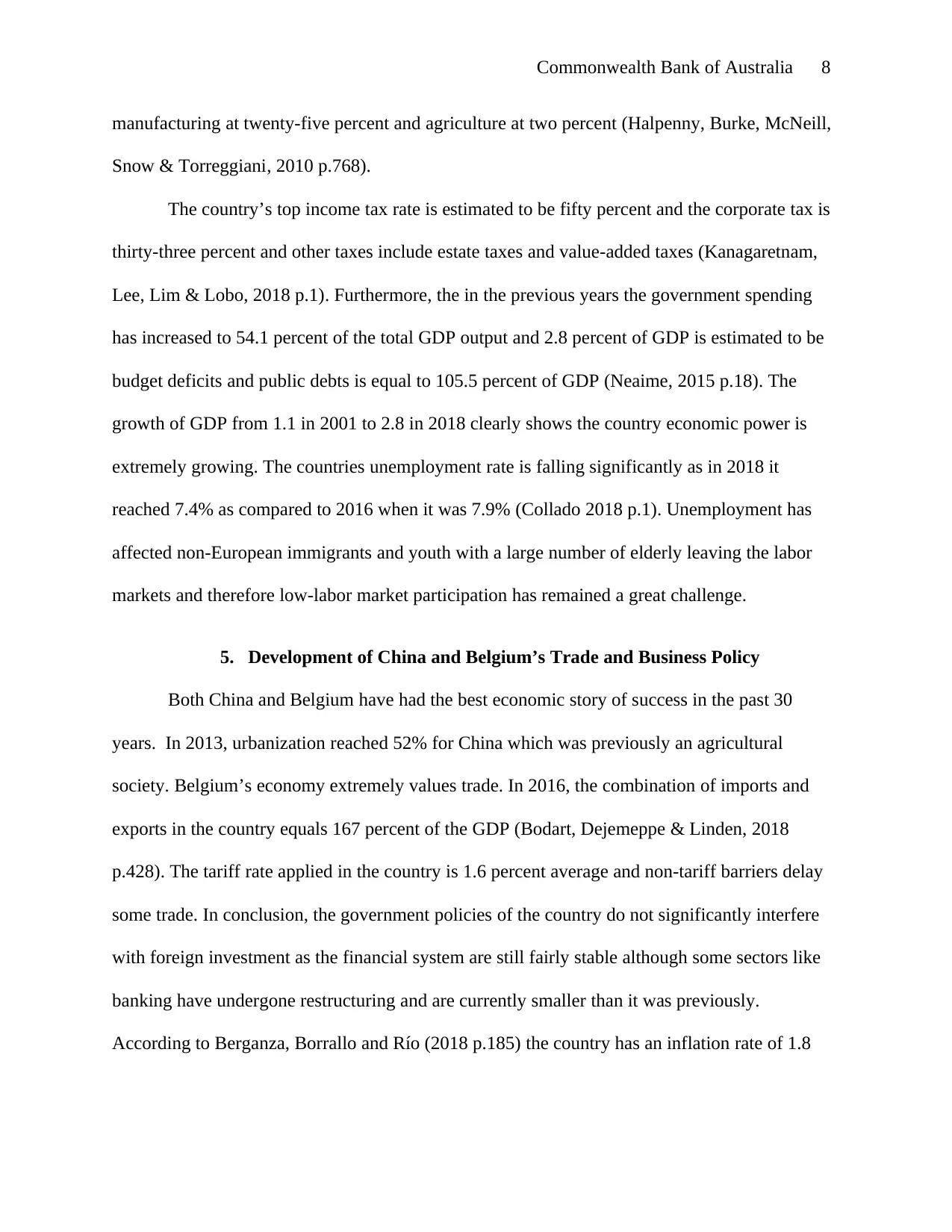
Commonwealth Bank of Australia 8
manufacturing at twenty-five percent and agriculture at two percent (Halpenny, Burke, McNeill,
Snow & Torreggiani, 2010 p.768).
The country’s top income tax rate is estimated to be fifty percent and the corporate tax is
thirty-three percent and other taxes include estate taxes and value-added taxes (Kanagaretnam,
Lee, Lim & Lobo, 2018 p.1). Furthermore, the in the previous years the government spending
has increased to 54.1 percent of the total GDP output and 2.8 percent of GDP is estimated to be
budget deficits and public debts is equal to 105.5 percent of GDP (Neaime, 2015 p.18). The
growth of GDP from 1.1 in 2001 to 2.8 in 2018 clearly shows the country economic power is
extremely growing. The countries unemployment rate is falling significantly as in 2018 it
reached 7.4% as compared to 2016 when it was 7.9% (Collado 2018 p.1). Unemployment has
affected non-European immigrants and youth with a large number of elderly leaving the labor
markets and therefore low-labor market participation has remained a great challenge.
5. Development of China and Belgium’s Trade and Business Policy
Both China and Belgium have had the best economic story of success in the past 30
years. In 2013, urbanization reached 52% for China which was previously an agricultural
society. Belgium’s economy extremely values trade. In 2016, the combination of imports and
exports in the country equals 167 percent of the GDP (Bodart, Dejemeppe & Linden, 2018
p.428). The tariff rate applied in the country is 1.6 percent average and non-tariff barriers delay
some trade. In conclusion, the government policies of the country do not significantly interfere
with foreign investment as the financial system are still fairly stable although some sectors like
banking have undergone restructuring and are currently smaller than it was previously.
According to Berganza, Borrallo and Río (2018 p.185) the country has an inflation rate of 1.8
manufacturing at twenty-five percent and agriculture at two percent (Halpenny, Burke, McNeill,
Snow & Torreggiani, 2010 p.768).
The country’s top income tax rate is estimated to be fifty percent and the corporate tax is
thirty-three percent and other taxes include estate taxes and value-added taxes (Kanagaretnam,
Lee, Lim & Lobo, 2018 p.1). Furthermore, the in the previous years the government spending
has increased to 54.1 percent of the total GDP output and 2.8 percent of GDP is estimated to be
budget deficits and public debts is equal to 105.5 percent of GDP (Neaime, 2015 p.18). The
growth of GDP from 1.1 in 2001 to 2.8 in 2018 clearly shows the country economic power is
extremely growing. The countries unemployment rate is falling significantly as in 2018 it
reached 7.4% as compared to 2016 when it was 7.9% (Collado 2018 p.1). Unemployment has
affected non-European immigrants and youth with a large number of elderly leaving the labor
markets and therefore low-labor market participation has remained a great challenge.
5. Development of China and Belgium’s Trade and Business Policy
Both China and Belgium have had the best economic story of success in the past 30
years. In 2013, urbanization reached 52% for China which was previously an agricultural
society. Belgium’s economy extremely values trade. In 2016, the combination of imports and
exports in the country equals 167 percent of the GDP (Bodart, Dejemeppe & Linden, 2018
p.428). The tariff rate applied in the country is 1.6 percent average and non-tariff barriers delay
some trade. In conclusion, the government policies of the country do not significantly interfere
with foreign investment as the financial system are still fairly stable although some sectors like
banking have undergone restructuring and are currently smaller than it was previously.
According to Berganza, Borrallo and Río (2018 p.185) the country has an inflation rate of 1.8
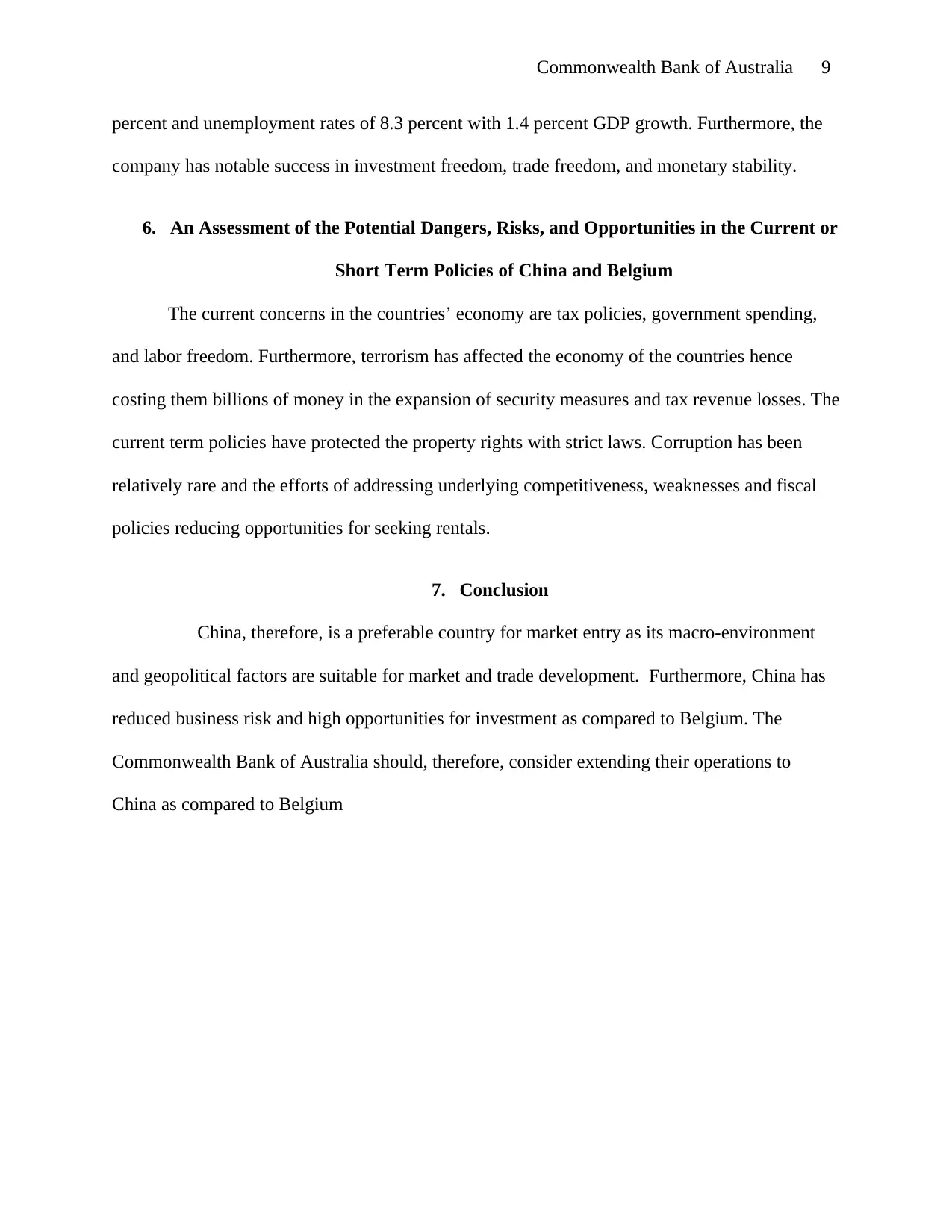
Commonwealth Bank of Australia 9
percent and unemployment rates of 8.3 percent with 1.4 percent GDP growth. Furthermore, the
company has notable success in investment freedom, trade freedom, and monetary stability.
6. An Assessment of the Potential Dangers, Risks, and Opportunities in the Current or
Short Term Policies of China and Belgium
The current concerns in the countries’ economy are tax policies, government spending,
and labor freedom. Furthermore, terrorism has affected the economy of the countries hence
costing them billions of money in the expansion of security measures and tax revenue losses. The
current term policies have protected the property rights with strict laws. Corruption has been
relatively rare and the efforts of addressing underlying competitiveness, weaknesses and fiscal
policies reducing opportunities for seeking rentals.
7. Conclusion
China, therefore, is a preferable country for market entry as its macro-environment
and geopolitical factors are suitable for market and trade development. Furthermore, China has
reduced business risk and high opportunities for investment as compared to Belgium. The
Commonwealth Bank of Australia should, therefore, consider extending their operations to
China as compared to Belgium
percent and unemployment rates of 8.3 percent with 1.4 percent GDP growth. Furthermore, the
company has notable success in investment freedom, trade freedom, and monetary stability.
6. An Assessment of the Potential Dangers, Risks, and Opportunities in the Current or
Short Term Policies of China and Belgium
The current concerns in the countries’ economy are tax policies, government spending,
and labor freedom. Furthermore, terrorism has affected the economy of the countries hence
costing them billions of money in the expansion of security measures and tax revenue losses. The
current term policies have protected the property rights with strict laws. Corruption has been
relatively rare and the efforts of addressing underlying competitiveness, weaknesses and fiscal
policies reducing opportunities for seeking rentals.
7. Conclusion
China, therefore, is a preferable country for market entry as its macro-environment
and geopolitical factors are suitable for market and trade development. Furthermore, China has
reduced business risk and high opportunities for investment as compared to Belgium. The
Commonwealth Bank of Australia should, therefore, consider extending their operations to
China as compared to Belgium
⊘ This is a preview!⊘
Do you want full access?
Subscribe today to unlock all pages.

Trusted by 1+ million students worldwide
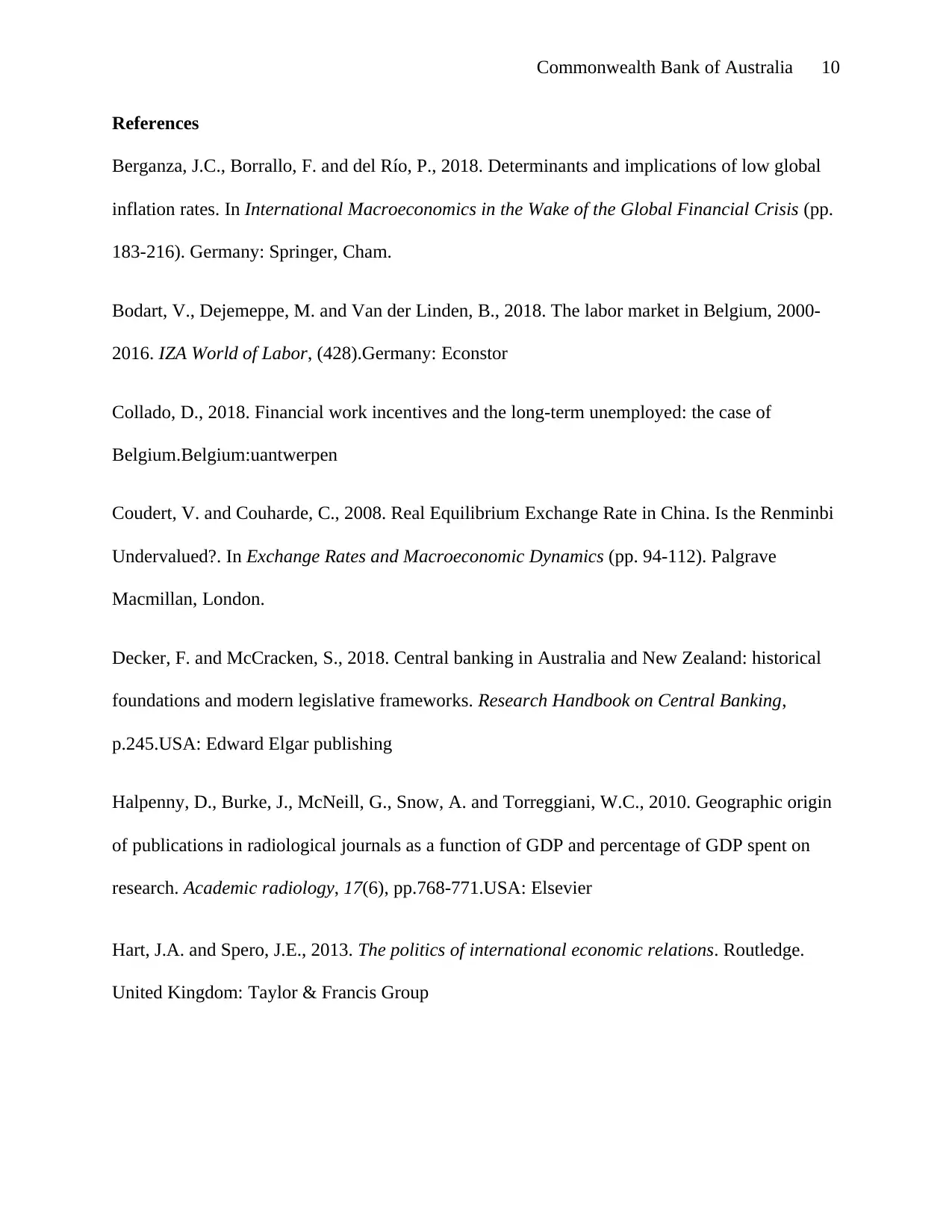
Commonwealth Bank of Australia 10
References
Berganza, J.C., Borrallo, F. and del Río, P., 2018. Determinants and implications of low global
inflation rates. In International Macroeconomics in the Wake of the Global Financial Crisis (pp.
183-216). Germany: Springer, Cham.
Bodart, V., Dejemeppe, M. and Van der Linden, B., 2018. The labor market in Belgium, 2000-
2016. IZA World of Labor, (428).Germany: Econstor
Collado, D., 2018. Financial work incentives and the long-term unemployed: the case of
Belgium.Belgium:uantwerpen
Coudert, V. and Couharde, C., 2008. Real Equilibrium Exchange Rate in China. Is the Renminbi
Undervalued?. In Exchange Rates and Macroeconomic Dynamics (pp. 94-112). Palgrave
Macmillan, London.
Decker, F. and McCracken, S., 2018. Central banking in Australia and New Zealand: historical
foundations and modern legislative frameworks. Research Handbook on Central Banking,
p.245.USA: Edward Elgar publishing
Halpenny, D., Burke, J., McNeill, G., Snow, A. and Torreggiani, W.C., 2010. Geographic origin
of publications in radiological journals as a function of GDP and percentage of GDP spent on
research. Academic radiology, 17(6), pp.768-771.USA: Elsevier
Hart, J.A. and Spero, J.E., 2013. The politics of international economic relations. Routledge.
United Kingdom: Taylor & Francis Group
References
Berganza, J.C., Borrallo, F. and del Río, P., 2018. Determinants and implications of low global
inflation rates. In International Macroeconomics in the Wake of the Global Financial Crisis (pp.
183-216). Germany: Springer, Cham.
Bodart, V., Dejemeppe, M. and Van der Linden, B., 2018. The labor market in Belgium, 2000-
2016. IZA World of Labor, (428).Germany: Econstor
Collado, D., 2018. Financial work incentives and the long-term unemployed: the case of
Belgium.Belgium:uantwerpen
Coudert, V. and Couharde, C., 2008. Real Equilibrium Exchange Rate in China. Is the Renminbi
Undervalued?. In Exchange Rates and Macroeconomic Dynamics (pp. 94-112). Palgrave
Macmillan, London.
Decker, F. and McCracken, S., 2018. Central banking in Australia and New Zealand: historical
foundations and modern legislative frameworks. Research Handbook on Central Banking,
p.245.USA: Edward Elgar publishing
Halpenny, D., Burke, J., McNeill, G., Snow, A. and Torreggiani, W.C., 2010. Geographic origin
of publications in radiological journals as a function of GDP and percentage of GDP spent on
research. Academic radiology, 17(6), pp.768-771.USA: Elsevier
Hart, J.A. and Spero, J.E., 2013. The politics of international economic relations. Routledge.
United Kingdom: Taylor & Francis Group
Paraphrase This Document
Need a fresh take? Get an instant paraphrase of this document with our AI Paraphraser
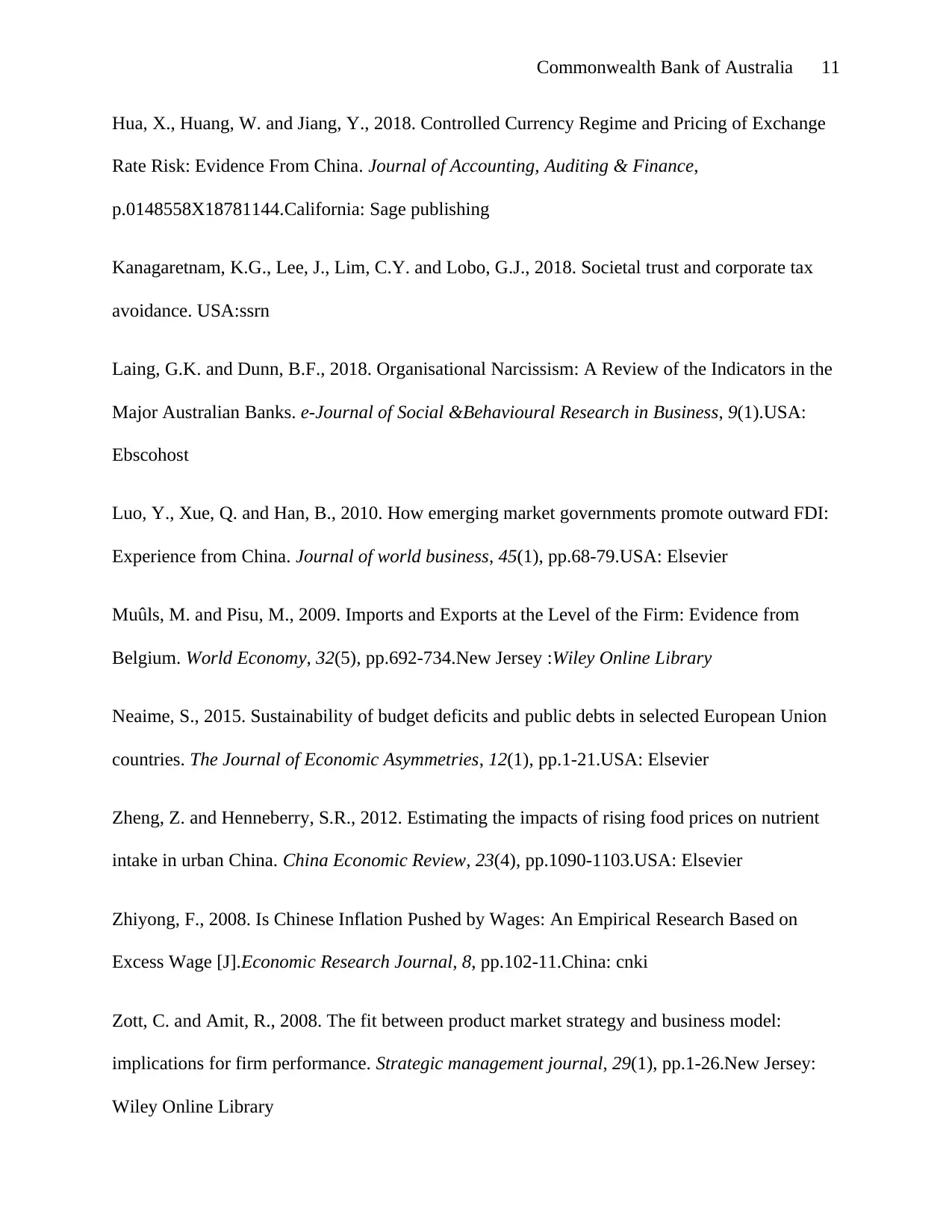
Commonwealth Bank of Australia 11
Hua, X., Huang, W. and Jiang, Y., 2018. Controlled Currency Regime and Pricing of Exchange
Rate Risk: Evidence From China. Journal of Accounting, Auditing & Finance,
p.0148558X18781144.California: Sage publishing
Kanagaretnam, K.G., Lee, J., Lim, C.Y. and Lobo, G.J., 2018. Societal trust and corporate tax
avoidance. USA:ssrn
Laing, G.K. and Dunn, B.F., 2018. Organisational Narcissism: A Review of the Indicators in the
Major Australian Banks. e-Journal of Social &Behavioural Research in Business, 9(1).USA:
Ebscohost
Luo, Y., Xue, Q. and Han, B., 2010. How emerging market governments promote outward FDI:
Experience from China. Journal of world business, 45(1), pp.68-79.USA: Elsevier
Muûls, M. and Pisu, M., 2009. Imports and Exports at the Level of the Firm: Evidence from
Belgium. World Economy, 32(5), pp.692-734.New Jersey :Wiley Online Library
Neaime, S., 2015. Sustainability of budget deficits and public debts in selected European Union
countries. The Journal of Economic Asymmetries, 12(1), pp.1-21.USA: Elsevier
Zheng, Z. and Henneberry, S.R., 2012. Estimating the impacts of rising food prices on nutrient
intake in urban China. China Economic Review, 23(4), pp.1090-1103.USA: Elsevier
Zhiyong, F., 2008. Is Chinese Inflation Pushed by Wages: An Empirical Research Based on
Excess Wage [J].Economic Research Journal, 8, pp.102-11.China: cnki
Zott, C. and Amit, R., 2008. The fit between product market strategy and business model:
implications for firm performance. Strategic management journal, 29(1), pp.1-26.New Jersey:
Wiley Online Library
Hua, X., Huang, W. and Jiang, Y., 2018. Controlled Currency Regime and Pricing of Exchange
Rate Risk: Evidence From China. Journal of Accounting, Auditing & Finance,
p.0148558X18781144.California: Sage publishing
Kanagaretnam, K.G., Lee, J., Lim, C.Y. and Lobo, G.J., 2018. Societal trust and corporate tax
avoidance. USA:ssrn
Laing, G.K. and Dunn, B.F., 2018. Organisational Narcissism: A Review of the Indicators in the
Major Australian Banks. e-Journal of Social &Behavioural Research in Business, 9(1).USA:
Ebscohost
Luo, Y., Xue, Q. and Han, B., 2010. How emerging market governments promote outward FDI:
Experience from China. Journal of world business, 45(1), pp.68-79.USA: Elsevier
Muûls, M. and Pisu, M., 2009. Imports and Exports at the Level of the Firm: Evidence from
Belgium. World Economy, 32(5), pp.692-734.New Jersey :Wiley Online Library
Neaime, S., 2015. Sustainability of budget deficits and public debts in selected European Union
countries. The Journal of Economic Asymmetries, 12(1), pp.1-21.USA: Elsevier
Zheng, Z. and Henneberry, S.R., 2012. Estimating the impacts of rising food prices on nutrient
intake in urban China. China Economic Review, 23(4), pp.1090-1103.USA: Elsevier
Zhiyong, F., 2008. Is Chinese Inflation Pushed by Wages: An Empirical Research Based on
Excess Wage [J].Economic Research Journal, 8, pp.102-11.China: cnki
Zott, C. and Amit, R., 2008. The fit between product market strategy and business model:
implications for firm performance. Strategic management journal, 29(1), pp.1-26.New Jersey:
Wiley Online Library
1 out of 11
Related Documents
Your All-in-One AI-Powered Toolkit for Academic Success.
+13062052269
info@desklib.com
Available 24*7 on WhatsApp / Email
![[object Object]](/_next/static/media/star-bottom.7253800d.svg)
Unlock your academic potential
Copyright © 2020–2025 A2Z Services. All Rights Reserved. Developed and managed by ZUCOL.





